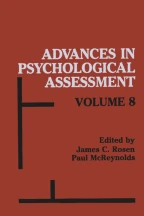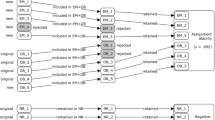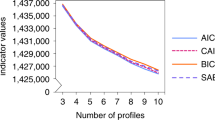Assessing Psychopathology Using the Basic Personality Inventory: Rationale and Applications

This chapter provides a guide to the use and interpretation of the Basic Personality Inventory (BPI; Jackson, 1976). In doing so, greater emphasis is placed on describing the applied aspects of the test with less of a focus on the instrument’s intricate psychometric development. Those with an interest in a more extensive discussion of the multivariate statistical details are referred to the Basic Personality Inventory Manual (Jackson, Helmes, Hoffmann, Holden, Jaffe, Reddon, & Smiley, 1989).
This is a preview of subscription content, log in via an institution to check access.
Access this chapter
Subscribe and save
Springer+ Basic
€32.70 /Month
- Get 10 units per month
- Download Article/Chapter or eBook
- 1 Unit = 1 Article or 1 Chapter
- Cancel anytime
Buy Now
Price includes VAT (France)
eBook EUR 85.59 Price includes VAT (France)
Softcover Book EUR 105.49 Price includes VAT (France)
Hardcover Book EUR 105.49 Price includes VAT (France)
Tax calculation will be finalised at checkout
Purchases are for personal use only
Preview
Similar content being viewed by others

A Concurrent Validity Study of the PDM-2 Personality Syndromes
Article 17 July 2017

The revised Edward Zigler Yale-Personality Questionnaire (EZPQ) for persons with intellectual disability: A new four-factor structure in confirmatory factor analysis
Article Open access 22 May 2020

Establishing the structure and replicability of personality profiles using the HEXACO-PI-R
Article 06 April 2020
References
- Austin, G.W., Leschied, A.W., Jaffe, P.G., and Sas, L. (1986). Factor structure and construct validity of the Basic Personality Inventory with juvenile offenders. Canadian Journal of Behavioural Science, 18, 238–247. ArticleGoogle Scholar
- Bagby, R.M., Gillis, J.R., and Dickens, S. (1990). Detection of dissimulation with the new generation of objective personality measures. Behavioral Sciences and the Law, 8, 93–102. ArticleGoogle Scholar
- Bagby, RM., Taylor, G.J., andRyan, D. (1986). Toronto alexithymia scale: Relationship with personality and psychopathology measures. Psychotherapy and Psychosomatics, 45, 207–215. ArticlePubMedGoogle Scholar
- Beck, A.T. (1967). Depression: Causes and treatment. Philadelphia: University of Pennsylvania Press. Google Scholar
- Blashfield, R.K. (1984). The classification of psychopathology. New York: Plenum. BookGoogle Scholar
- Burton, H.J., Canzona, L., Wai, L., Holden, R.R., Conley, J., and Lindsay, R.H. (1983). Life without the machine: A look at psychological determinants for successful adaptation of patients on CAPD. In N. Levy (Ed.), Psychonephrology 2: Psychological problems in kidney failure and their treatment. (pp. 159–172 ) New York, NY: Plenum. Google Scholar
- Burton, H.J., and Holden, R.R. ( 1981, August). Psychological factors related to successful adaptation for chronic renal patients. Paper presented at the American Psychological Association Annual Convention, Los Angeles. Google Scholar
- Burton, H.J., Kline, S.A., Lindsay, R.M., andHeidenheim, A.P. (1986). The relationship of depression to survival in chronic renal failure. Psychosomatic Medicine, 48, 261–269. PubMedGoogle Scholar
- Butcher, J.N., Dahlstrom, W.G., Graham, J.K., Tellegen, A., and Kaemmer, B. (1989). Manual for the restandardized Minnesota Multiphasic Personality Inventory: MMPI-2. An administrative and interpretive guide. Minneapolis: University of Minnesota Press. Google Scholar
- Cameron, N., and Magaret, A. (1951). Behavior pathology. Boston: Houghton-Mifflin. Google Scholar
- Campbell, D.T., and Fiske, D.W. (1959). Convergent and discriminant validation by the multitrait-multimethod matrix. Psychological Bulletin, 56, 81–105. ArticlePubMedGoogle Scholar
- Chandarana, P., Helmes, E., and Benson, N. (1988). Eating attitudes as related to demographic and personality characteristics: A high school survey. CanadianJournal of Psychiatry, 33, 834–837. Google Scholar
- Conger, A.J., and Jackson, D.N. (1972). Suppressor variables, prediction, and the interpretation of psychological relationships. Educational and Psychological Measurement, 32, 579–599. ArticleGoogle Scholar
- Faschingbauer, T.R. (1979). The future of the MMPI. In C.S. Newmark (Ed.), MMPIclinical and research trends. (pp. 373–398 ) New York, NY: Praeger. Google Scholar
- Hathaway, S.R., and McKinley, J.D. (1940). A multiphasic personality schedule: I. Construction of the schedule. Journal of Psychology, 10, 249–254. ArticleGoogle Scholar
- Helmes, E., and Barilko, O. (1988). Comparison of three multiscale inventories in identifying the presence of psychopathological symptoms.Joumal ofPersonal ityAssessment, 52, 74–80. Google Scholar
- Helmes, E., and Holden, R.R. (1986). Response styles and faking on the Basic Personality Inventory. Journal of Consulting and Clinical Psychology, 54, 853–859. ArticlePubMedGoogle Scholar
- Holden, R.R. (1989). Disguise and the structured self-report assessment of psychopathology: II. A clinical replication. Journal of Clinical Psychology, 45, 583–586. ArticlePubMedGoogle Scholar
- Holden, R.R., Burton, H.J., andConley, J. (1981). Psychological correlates of adjustment to continuous ambulatory peritoneal dialysis: Normative and clinical data. Unpublished manuscript. Google Scholar
- Holden, R.R., and Fekken, G.C. ( 1987, August). Reaction time and self-report psychopathological assessment: Convergent and discriminant validity. Paper prsented at the American Psychological Association Annual Convention, New York. Google Scholar
- Holden, R.R., and Fekken, G.C. (1988, June). Using reaction time to detect faking on a computerized inventory of psychopathology. Paper presented at the Canadian Psychological Association Annual Convention, Montreal, Canada. Google Scholar
- Holden, R.R., and Fekken, G.C. (1990). Structured psychopathological test item characteristics and validity. Psychological Assessment: A Journal of Consulting and Clinical Psychology, 2, 35–40. Google Scholar
- Holden, R.R., Fekken, G.C., and Cotton, D.H.G. (1990). Clinical reliabilities and validities of the microcomputerized Basic Personality Inventory. Journal of Clinical Psychology, 46, 845–849. ArticlePubMedGoogle Scholar
- Holden, R.R., Fekken, G.C., and Cotton, D.H.G. (1991). Assessing psychopathology using structured test item response latencies. Psychological Assessment: A Journal of Consulting and Clinical Psychology, 3, 000–000. Google Scholar
- Holden, R.R., Fekken, G.C., and Jackson, D.N. (1983, June). Diagnostic efficiency of the Basic Personaltiy Inventory. Paper presented at the Canadian Psychological Association Annual Convention, Winnipeg, Canada. Google Scholar
- Holden, R.R., Fekken, G.C., Reddon, J.R., Helmes, E., and Jackson, D.N. (1988). Clinical reliabilities and validities of the Basic Personality Inventory. Journal of Consulting and Clinical Psychology, 56, 766–768. ArticlePubMedGoogle Scholar
- Holden, R.R., Helmes, E., Fekken, G.C., and Jackson, D.N. (1985). The multidimensionality of person reliability:Implications for interpreting individual test item responses. Educational and Psychological Measurement, 45, 119–130. ArticleGoogle Scholar
- Holden, R.R., and Jackson, D.N. (1985). Disguise and the structured self-report assessment of psychopathology: I. An analogue investigation. Journal of Consulting and Clinical Psychology, 53, 211–222. ArticlePubMedGoogle Scholar
- Holden, R.R., Reddon, J.R., Jackson, D.N., and Helmes, E. (1983). The construct heuristic applied to the measurement of psychopathology. Multivariate Behavioral Research, 18, 3746. ArticleGoogle Scholar
- Jackson, D.N. (1970). A sequential system for personality scale development. In C.D. Spielberger (Ed.), Current topics in clinical and community psychology (Vol. 2, pp. 61–96 ). New York: Academic Press. Google Scholar
- Jackson, D.N. (1971). The dynamics of structured personality tests: 1971. Psychological Review, 78, 229–248. (Reprinted as a Warner Modular Publication, 1973, 320, 1–20.) Google Scholar
- Jackson, D.N. (1976). The Basic Personality Inventory. Port Huron, MI: Sigma Assessment Systems. Google Scholar
- Jackson, D.N., Helmes, E., Hoffmann, H., Holden, R.R., Jaffe, P.G., Reddon, J.R. and Smiley, W.C. (1989). The Basic Personality Inventory Manual. Port Huron, MI: Sigma Assessment Systems. Google Scholar
- Jackson, D.N., and Hoffmann, H. (1987). Common dimensions of psychopathology from the MMPI and the Basic Personalitylnventory. Journal of Clinical Psychology, 43, 661–669. ArticlePubMedGoogle Scholar
- Jackson, D.N., MacLennan, R.N., Erdle, S.W.P., Holden, R.R., LaLonde, R.N., and Thompson, G.R. (1986). Clinical judgments of depression. Journal of Clinical Psychology, 42, 136–145. ArticlePubMedGoogle Scholar
- Jackson, D.N., and Messick, S. (1969). A distinction between judgments of frequency and of desirability as determinants of response. Educational and Psychological Measurement, 29, 273–294. ArticleGoogle Scholar
- Jackson, D.N. and Messick, S. (1986). The Differential Personality Inventory. London, Canada: Authors. Google Scholar
- Jaffe, P.G., Leschied, A.W., Sas, L., andAustin, G.W. (1985). A model for the provision of clinical assessments and service brokerage for young offenders: The London Family Court Clinic. Canadian Psychology, 26, 54–61. ArticleGoogle Scholar
- Jaffe, P.G., Leschied, A.W., Sas, L., Austin, G.W., and Smiley, W.C. (1985). The utility of the Basic Personality Inventory in the assessment of young offenders. Ontario Psychologist, 17, 4–11. Google Scholar
- Lei, H., and Skinner, H.A. (1980). A psychometric study of life events and social readjustment. Journal of Psychosomatic Research, 24, 57–65. ArticlePubMedGoogle Scholar
- Leschied, A.W., Austin, G.W., andJaffe, P.G. (1988). Impact of the young offenders act on recidivism rates of special needs youth: Clinical and policy implications. Canadian Journal of Behavioural Science, 20, 322–331. ArticleGoogle Scholar
- Levitt, E.E. andDuckworth, J.C. (1984). Minnesota Multiphasic Personality Inventory. In D.J. Keyser and R.C. Sweetland (Eds.), Test critiques. (Vol. I, pp. 466–472 ) Kansas City: Test Corporation of America. Google Scholar
- Livesley, W.J., Schroeder, M.L., and Jackson, D.N. (1989). A study of the factorial structure of personality pathology. Journal of Personality Disorders, 3, 292–306. ArticleGoogle Scholar
- Loevinger, J. (1957). Objective tests as instruments of psychological theory. Psychological Reports, 3, 635–694. Google Scholar
- Loper, R.G., Kammeier, M.L., and Hoffmann, H. (1973). MMPI characteristics of college freshmen males who later became alcoholics. Journal of Abnormal Psychology, 82, 159–162. ArticlePubMedGoogle Scholar
- Meehl, P.E., and Rosen, A. (1955). Antecedent probability and the efficiency of psychometric signs, patterns, or cutting scores. Psychological Bulletin, 52, 194–216. ArticlePubMedGoogle Scholar
- Messick, S. (1989). Validity. In R. Linn (Ed.), Educational measurement ( 3rd ed. ) (pp. 13–103 ). New York: American Council on Education. Google Scholar
- Morey, L.C., Blashfield, R.K., and Skinner, H.A. (1983). A comparison of cluster analysis techniques within a sequential validation framework. Multivariate Behavioral Research, 18, 309–329. ArticleGoogle Scholar
- Morey, L.C., Skinner, H.A., andBlashfield, R.K. (1984). A typology of alcohol abusers: Correlates and implications. Journal of Abnormal Psychology, 93, 408–417. ArticlePubMedGoogle Scholar
- Neill, J.A., andJackson, D.N. (1976). Minimum redundancy item analysis. Educational and Psychological Measurement, 36, 123–134. ArticleGoogle Scholar
- Office of Strategic Services, Assessment Staff. (1948). Assessmentofmen: Selection of personnel for the Office of Strategic Services. New York: Holt, Rinehart and Winston. Google Scholar
- Ogborne, A.C. (1987). A note on the characteristics of alcohol abusers with controlled drinking aspirations. Drug and Alcohol Dependence, 19, 159–164. ArticlePubMedGoogle Scholar
- Reddon, J.R., andJackson, D.N. (1989). Readability of three adult personality tests: Basic Personality Inventory, Jackson Personality Inventory, and Personality Research Form–E. Journal of Personality Assessment, 53, 180–183. ArticleGoogle Scholar
- Reddon, J.R., Marceau, R., and Jackson, D.N. (1982). An application of singular value decomposition to the factor analysis of MMPI items. Applied Psychological Measurement, 6, 275–283. ArticleGoogle Scholar
- Richmond, J.M., Lindsay, R.M., Burton, H.J., Conley, J., and Wai, L. (1982). Psychological and physiological factors predicting the outcome of home dialysis. Clinical Nephrology, 17, 109–113. PubMedGoogle Scholar
- Sas, L., and Jaffe, P.G. (1986). Understanding depression in juvenile delinquency: Implications for institutional admission policies and admission programs. Juvenile and Family Court Journal, 37, 49–58. ArticleGoogle Scholar
- Sas, L., Jaffe, P.G., andReddon, J.R. (1985). Unravelling the needs of dangerous young offenders: A clinical-rational and empirical approach to classification. Canadian Journal of Criminology, 27, 83–96. Google Scholar
- Scudds, R.A., Rollman, G.B., Hart, M., and McCain, G.A. (1987). Pain perception and personality measures as discriminators in the classification of fibrositis. Journal of Rheumatology, 14, 563–569. PubMedGoogle Scholar
- Skinner, H.A. (1979). A multivariate evaluation of the MAST. Journal of Studies on Alcohol, 40, 831–843. PubMedGoogle Scholar
- Skinner, H.A. (1981). Primary syndromes of alcohol abuse: Their measurement and correlates. British Journal of Addiction, 76, 63–76. ArticlePubMedGoogle Scholar
- Skinner, H.A. (1982). The Drug Abuse Screening Test. Addictive Behaviors, 7, 363–371. ArticlePubMedGoogle Scholar
- Skinner, H.A., and Allen, B.A. (1982). Alcohol dependence syndrome: Measurement and validation. Journal of Abnormal Psychology, 91, 199–209. ArticlePubMedGoogle Scholar
- Skinner, H.A., andAllen, B.A. (1983). DIfferential assessment of alcoholism: Evaluation of the Alcohol Use Inventory. Journal of Studies on Alcohol, 44, 852–862. PubMedGoogle Scholar
- Spielberger, C.D. (1983). State-Trait Anxiety Inventory (Form 19 Manual. Palo Alto: Consulting Psychologists Press. Google Scholar
- Strauss, J.S., and Harder, D.W. (1981). The Case Record Rating Scale: A method for rating symptom and social function data from case records. Psych iatryResearch, 4, 333–345. Google Scholar
Author information
Authors and Affiliations
- Department of Psychology, Queen’s University, Kingston, Ontario, Canada Ronald R. Holden
- Department of Psychology, The University of Western Ontario, London, Ontario, Canada Douglas N. Jackson ( Senior Professor )
- Ronald R. Holden
You can also search for this author in PubMed Google Scholar
You can also search for this author in PubMed Google Scholar
Editor information
Editors and Affiliations
- Department of Psychology, University of Vermont, Burlington, Vermont, USA James C. Rosen ( Professor and Director of the Clinical Psychology Program ) ( Professor and Director of the Clinical Psychology Program )
- University of Nevada-Reno, Reno, Nevada, USA Paul McReynolds ( Emeritus Professor of Psychology ) ( Emeritus Professor of Psychology )
Rights and permissions
Copyright information
© 1992 Springer Science+Business Media New York
About this chapter
Cite this chapter
Holden, R.R., Jackson, D.N. (1992). Assessing Psychopathology Using the Basic Personality Inventory: Rationale and Applications. In: Rosen, J.C., McReynolds, P. (eds) Advances in Psychological Assessment. Advances in Psychological Assessment, vol 8. Springer, Boston, MA. https://doi.org/10.1007/978-1-4757-9101-3_6
Download citation
- DOI : https://doi.org/10.1007/978-1-4757-9101-3_6
- Publisher Name : Springer, Boston, MA
- Print ISBN : 978-1-4757-9103-7
- Online ISBN : 978-1-4757-9101-3
- eBook Packages : Springer Book Archive
Share this chapter
Anyone you share the following link with will be able to read this content:
Get shareable link
Sorry, a shareable link is not currently available for this article.
Copy to clipboard
Provided by the Springer Nature SharedIt content-sharing initiative




